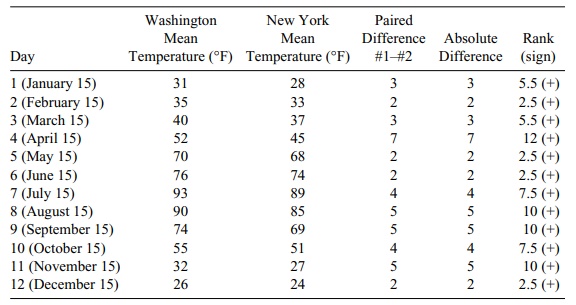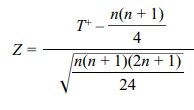Wilcoxon Signed-Rank Test
| Home | | Advanced Mathematics |Chapter: Biostatistics for the Health Sciences: Nonparametric Methods
Remember that a paired t test involved taking the difference between two paired observations.
WILCOXON SIGNED-RANK TEST
Remember that a paired t test involved taking the difference between two paired
observations, i.e., di = Xit1 – Xit2. The Wilcoxon
signed-rank test is a nonparametric rank test that is analogous to the paired t test but is applicable when the
differences (di) between
the two groups are not approximately normally distributed. The procedure of
the Wilcoxon signed-rank test involves first computing the paired differ-ences,
as with the t test. The absolute
values of the differences are then computed and the data ranked based on these
absolute differences. After the ranks are deter-mined, the observations are
split into two distinct groups that separate the ones that have negative
differences from the ones that have positive differences. The rank sums are
then computed for the positive differences, with the test statistic denoted as T+. This test statistic is
then compared to the tables for the signed-rank test; the tables are based on
the distribution of this statistic when the central tendencies of the two
populations are the same. Alternatively, we could have computed the sum of the
negative ranks and denoted it by T–.
If the two populations are the same, the paired
differences will be symmetric about zero and therefore will have about the same
number of positive and negative differences, and the magnitude of these
differences will not depend on the sign (i.e., whether or not they are in the
positive difference group). Assume that we find the differences between paired
observations by subtracting the values for the second observation from the
values for the first observation (as shown in Table 14.4). If the proportion of
positive differences is high, it suggests that population one has a high-er
median than population two. A low proportion of positive differences indicates
that population one has a lower median than population two. In the event that a
par-ticular paired difference is identical (i.e., 0), that observation is omitted
from the calculation, and we proceed as if the number of pairs is one less than
the original number.
Recall from Chapter 9 the two cities data that we
used to illustrate the paired t test.
We will use these data to demonstrate how the signed-rank test works. (See
Table 14.4.)
The fact that all the ranks are positive is a
strong indicator that Washington was warmer than New York. This finding
replicates the very highly significant differ-ence that was found using the
paired t test.
The absolute value of the difference determines the
ranks. The smallest absolute value gets rank 1, the next rank 2, and so on
until we reach the largest with rank 12. However, in the example in Table 14.4
there is a tie for the lowest, with four cases having the value 2. When ties
occur, all tied observations get the average of the tied ranks. So the average
of ranks 1, 2, 3, and 4 is 10/4 = 2.5. Similarly the observed ab-solute
difference of 3 is tied in two cases and hence the average of the ranks 5 and 6
gives a rank of 5.5 to each of those tied observations.
The sum of the positive ranks is 78, and the sum of
the negative ranks is 0. Since n is
small (12), we refer to the tables for the signed-rank test statistic. Recall
that the
TABLE 14.4. Daily Temperatures, Washington versus New York

Referring to Appendix C,
we find that for n = 12 and p = 0.005, the critical value is 8.
This outcome means that the probability of
observing a value less than 8 is 0.005. Similarly, from the tables the
probability of observing a value greater than 70 is 0.005. This is based on
symmetry since the prob-ability of the positive ranks being less than 8 under
the null hypothesis is the same as the probability of being greater than 78 – 8
= 70. Since we observed a signed-rank score of 78, we know that the one-sided p-value is less than 0.005. So we
conclude that there is a difference between the two populations in the mean
temperature.
A normal approximation can be used for large n. Conover (1999) recommends that n be at least 50.
Let

Then Z
has approximately a standard normal distribution. So the standard normal tables
(Appendix E) may be used after calculating Z
in order to obtain an approxi-mate p-value
for large n.
Another normal approximation that is simpler than
the foregoing approximation is based on the statistic T = T+ – T–. The statistic T has a mean of zero under the null
hypothesis. So there is no expected value to subtract. For T (in the case when there are no ties) we define the standard
normal approximation as

In the event of ties, we use Z = T/ √ΣRi2, where Ri is the absolute rank of the ith observation (both positive and negative ranks are included in this
sum).
The temperature data (refer to Table 14.4) are
highly unusual because of the ex-treme differences between the two cities;
same-day pairing for each month of the year is used to remove the seasonal
effect. As a second example of pairing, we will look at how twins score on a
psychological test for aggressiveness (refer to Table 14.5). The data are from
Conover (1999). The research question being addressed is whether first-born
twins are more aggressive than second-born twins.
The value of n
is 11 because we discard one pair of observations for which the difference is
0. Here we see that the sum of the ranks for a sample size of 11 is 66 (1 + 2 +
3 + . . . + 11). From the paired difference column, we see that the sum of the
positive ranks is 41.5 and the sum of the negative ranks is 24.5. From the
table for the signed-rank test with n
= 11 (Appendix C), we see that the critical value at the one-sided 5%
significance level is 55. Given that the sum of the positive ranks is 41.5, we
cannot reject the null hypothesis because the p-value is greater than 0.05. Therefore, first-born twins do not
tend to be more aggressive than second-born twins.
TABLE 14.5. Aggressiveness Scores for 12 Sets of Identical Twins

The normal approximations for the signed-rank test,
recommended when n is 50 or more, are
summarized in Equations 14.3 (no ties) and 14.4 (ties). A normal approximation
to the Wilcoxon signed-rank test for comparing two dependent sam-ples (no ties)
is

where T =
T + – T – is the sum of the ranks, and n is the common sample size for both population 1 and population 2.
A normal approximation to the wilcoxon signed-rank test for comparing two
independent samples (ties) is

where T + – T – is the sum of the ranks, Σni=1R2i is the sum of the squares of the absolute ranks, and n is the common sample size for both population 1 and population 2.
Related Topics
